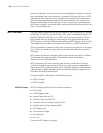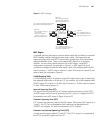Configuring STP 243
Generating the
Configuration BPDU
When initialized, each port of the switches will generate the configuration BPDU
taking itself as the root, root path cost as 0, designated switch IDs as their own
switch IDs, and the designated ports as their ports.
■ Switch A
Configuration BPDU of GigabitEthernet1/1/1: {0, 0, 0, e1/1/1}
Configuration BPDU of GigabitEthernet1/1/2: {0, 0, 0, e1/1/2}
■ Switch B
Configuration BPDU of GigabitEthernet1/1/7: {1, 0, 1, e1/1/7}
Configuration BPDU of GigabitEthernet1/1/4: {1, 0, 1, e1/1/4}
■ Switch C
Configuration BPDU of GigabitEthernet1/1/1: {2, 0, 2, e1/1/1}
Configuration BPDU of GigabitEthernet1/1/5: {2, 0, 2, e1/1/5}
Selecting the Optimum
Configuration BPDU
Every switch transmits its configuration BPDU to others. When a port receives a
configuration BPDU with a lower priority than that of its own, it will discard the
message and keep the local BPDU unchanged. When a higher-priority
configuration BPDU is received, the local configuration BPDU will be updated.
The optimum configuration BPDU will be elected through comparing the
configuration BPDUs of all the ports.
The comparison rules are:
■ The configuration BPDU with a smaller root ID has a higher priority
■ If the root IDs are the same, perform the comparison based on root path costs.
The cost comparison is as follows: the path cost to the root recorded in the
configuration BPDU plus the corresponding path cost of the local port is set as
X, the configuration BPDU with a smaller X has a higher priority.
■ If the costs of a path to the root are the same, compare, in sequence, the
designated switch ID, designated port ID, and the ID of the port through which
the configuration BPDU was received.
Designating the Root
Port
On a bridge, the port receiving the optimum configuration BPDU is considered the
root port whose configuration BPDU remains the same. Any other port, whose
configuration BPDU has been updated, as explained in
“Selecting the Optimum
Configuration BPDU”, will be blocked and will not forward any data. In addition,
any other port only receives, but does not retransmit, a BPDU and its BPDU
remains the same.
On other bridges, a port whose BPDU has not been updated is called the
designated port. Its configuration BPDU is modified by substituting:
■ The root ID with the root ID in the configuration BPDU of the root port
■ The cost of path to root with the value made by the root path cost, plus the
path cost corresponding to the root port
■ The designated switch ID with the local switch ID
■ The designated port ID with the local port ID


















